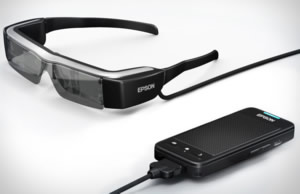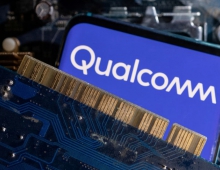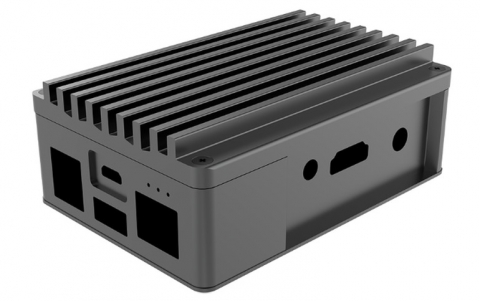
Qualcomm Announces Vuforia for Digital Eyewear, LTE Broadcast SDK, Demos Upcoming 810 SoC
Qualcomm is releasing the Vuforia developer kit for digital eyewear with companies like Samsung, Epson and others on board. The company also announced the general availability of the LTE Broadcast Software Development Kit (SDK), designed for developers of applications for LTE Broadcast capable devices featuring Qualcomm Snapdragon processors.
With the Qualcomm Vuforia mobile vision platform, Qualcomm hopes that developers will build augmented reality (AR) applications for a new generation of digital eyewear. The SDK will allow interactive 3D content to be visually aligned with the underlying world. This capability could enable new applications in hybrid VR/AR gaming, shopping, and education, as well as across a wide range of enterprise and industrial uses.
The Vuforia platform provides computer vision functionality for recognizing images and objects in the user's field of view. It also leverages Qualcomm Snapdragon processors to minimize the motion-to-photon latency that is so essential in delivering an authentic AR effect.
The Vuforia SDK for Digital Eyewear also includes a calibration method that enables Vuforia applications to dynamically adapt to a wearer's facial geometry, thereby providing an optimal experience.
 The Vuforia SDK for Digital Eyewear was designed to converge with recent release of the ODG R-7 and the Epson Moverio BT-200. Announced today by ODG, the R-7 features a fully integrated one-piece design, a stereoscopic see-through display system, wireless connectivity and the computing power of the Snapdragon 805 processor.
The Vuforia SDK for Digital Eyewear was designed to converge with recent release of the ODG R-7 and the Epson Moverio BT-200. Announced today by ODG, the R-7 features a fully integrated one-piece design, a stereoscopic see-through display system, wireless connectivity and the computing power of the Snapdragon 805 processor.
The Epson Moverio BT-200 smart glasses has an integrated see-through display system and utilizes a two-piece design. The smart glasses component includes sensors and the display system. The Android-powered control unit contains all other electronics and provides a touch pad for user interaction. The Moverio BT-200 is available now and ihas been designed for both consumer and enterprise augmented reality applications, including: environmental games, training solutions, museum experiences, and more.
Vuforia is also the first vision platform to enable a new class of hybrid VR/AR experiences on the Samsung Gear VR Innovator Edition powered by Oculus. With Vuforia SDK for Digital Eyewear, developers will be able to extend the capability of Gear VR further to incorporate AR experiences within VR applications, as well as create AR applications for gaming, education, and shopping.
The Vuforia SDK for Digital Eyewear will be available this Fall as a beta for a select group of developers.
In addition, Qualcomm today made available the LTE Broadcast Software Development Kit (SDK) through the Qualcomm Developer Network. Developers will be able to access a common application protocol interface (API) that can be used in all regions around the world that are trialing, testing or deploying LTE Broadcast.
To support LTE Broadcast functionality on smart devices, Qualcomm offers an LTE Broadcast solution for the evolved Multimedia Broadcast Multicast Service (eMBMS), which includes a Snapdragon processor, Qualcomm RaptorQ forward error correction technology, broadcast middleware, multimedia services and an interface for LTE Broadcast application development. Qualcomm Technologies' LTE Broadcast solution has been tested among the major infrastructure vendors over the past three years. LTE Broadcast is designed to support mobile network operators (MNOs) to more efficiently manage their spectrum and network loads by allowing the multicast of high-demand content such as live TV and sporting events, breaking news, and software and OS updates, so that multiple users receive the content simultaneously. LTE Broadcast utilizes standard LTE network architecture and modems, helping simplify implementations while lowering costs.
The LTE Broadcast SDK is designed, optimized and integrated for Snapdragon LTE capable processors. It provides libraries, tools and documentation for the development and testing of software applications intended for mobile devices capable of delivering LTE Broadcast services. The open API set included in the LTE Broadcast SDK can be used by application developers for multiple OEMs and operators.
The LTE Broadcast SDK is available now through the Qualcomm Developer Network.
Qualcomm also today at its Uplinq conference in San Francisco gave a brief demonstration of its Snapdragon 810 chip, which will start shipping in tablets and other devices early next year.
The company showed the chip rendering a 3D image of a sports car in a design program on an Android tablet. Changing the car's color and outer material showed how the chip could render the reflections and surface texture at the car turned.
The 810 has eight ARM CPU cores and can download data over some LTE networks at up to 300 Mbps. It also uses the Adreno 430 GPU, which allows devices with native 4K displays.
The Vuforia platform provides computer vision functionality for recognizing images and objects in the user's field of view. It also leverages Qualcomm Snapdragon processors to minimize the motion-to-photon latency that is so essential in delivering an authentic AR effect.
The Vuforia SDK for Digital Eyewear also includes a calibration method that enables Vuforia applications to dynamically adapt to a wearer's facial geometry, thereby providing an optimal experience.
 The Vuforia SDK for Digital Eyewear was designed to converge with recent release of the ODG R-7 and the Epson Moverio BT-200. Announced today by ODG, the R-7 features a fully integrated one-piece design, a stereoscopic see-through display system, wireless connectivity and the computing power of the Snapdragon 805 processor.
The Vuforia SDK for Digital Eyewear was designed to converge with recent release of the ODG R-7 and the Epson Moverio BT-200. Announced today by ODG, the R-7 features a fully integrated one-piece design, a stereoscopic see-through display system, wireless connectivity and the computing power of the Snapdragon 805 processor.
The Epson Moverio BT-200 smart glasses has an integrated see-through display system and utilizes a two-piece design. The smart glasses component includes sensors and the display system. The Android-powered control unit contains all other electronics and provides a touch pad for user interaction. The Moverio BT-200 is available now and ihas been designed for both consumer and enterprise augmented reality applications, including: environmental games, training solutions, museum experiences, and more.
Vuforia is also the first vision platform to enable a new class of hybrid VR/AR experiences on the Samsung Gear VR Innovator Edition powered by Oculus. With Vuforia SDK for Digital Eyewear, developers will be able to extend the capability of Gear VR further to incorporate AR experiences within VR applications, as well as create AR applications for gaming, education, and shopping.
The Vuforia SDK for Digital Eyewear will be available this Fall as a beta for a select group of developers.
In addition, Qualcomm today made available the LTE Broadcast Software Development Kit (SDK) through the Qualcomm Developer Network. Developers will be able to access a common application protocol interface (API) that can be used in all regions around the world that are trialing, testing or deploying LTE Broadcast.
To support LTE Broadcast functionality on smart devices, Qualcomm offers an LTE Broadcast solution for the evolved Multimedia Broadcast Multicast Service (eMBMS), which includes a Snapdragon processor, Qualcomm RaptorQ forward error correction technology, broadcast middleware, multimedia services and an interface for LTE Broadcast application development. Qualcomm Technologies' LTE Broadcast solution has been tested among the major infrastructure vendors over the past three years. LTE Broadcast is designed to support mobile network operators (MNOs) to more efficiently manage their spectrum and network loads by allowing the multicast of high-demand content such as live TV and sporting events, breaking news, and software and OS updates, so that multiple users receive the content simultaneously. LTE Broadcast utilizes standard LTE network architecture and modems, helping simplify implementations while lowering costs.
The LTE Broadcast SDK is designed, optimized and integrated for Snapdragon LTE capable processors. It provides libraries, tools and documentation for the development and testing of software applications intended for mobile devices capable of delivering LTE Broadcast services. The open API set included in the LTE Broadcast SDK can be used by application developers for multiple OEMs and operators.
The LTE Broadcast SDK is available now through the Qualcomm Developer Network.
Qualcomm also today at its Uplinq conference in San Francisco gave a brief demonstration of its Snapdragon 810 chip, which will start shipping in tablets and other devices early next year.
The company showed the chip rendering a 3D image of a sports car in a design program on an Android tablet. Changing the car's color and outer material showed how the chip could render the reflections and surface texture at the car turned.
The 810 has eight ARM CPU cores and can download data over some LTE networks at up to 300 Mbps. It also uses the Adreno 430 GPU, which allows devices with native 4K displays.




















